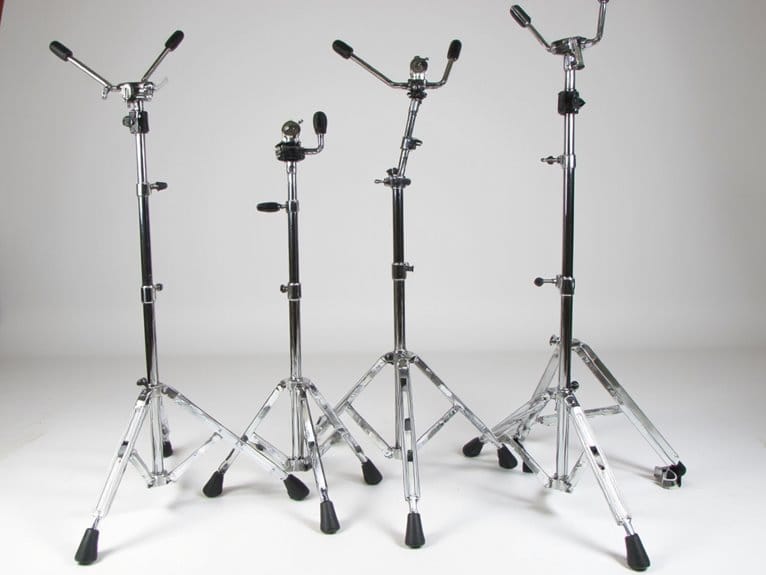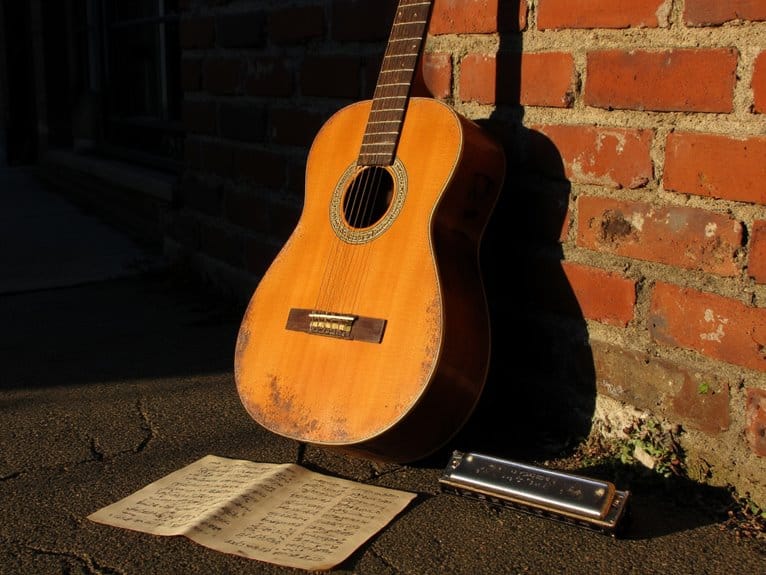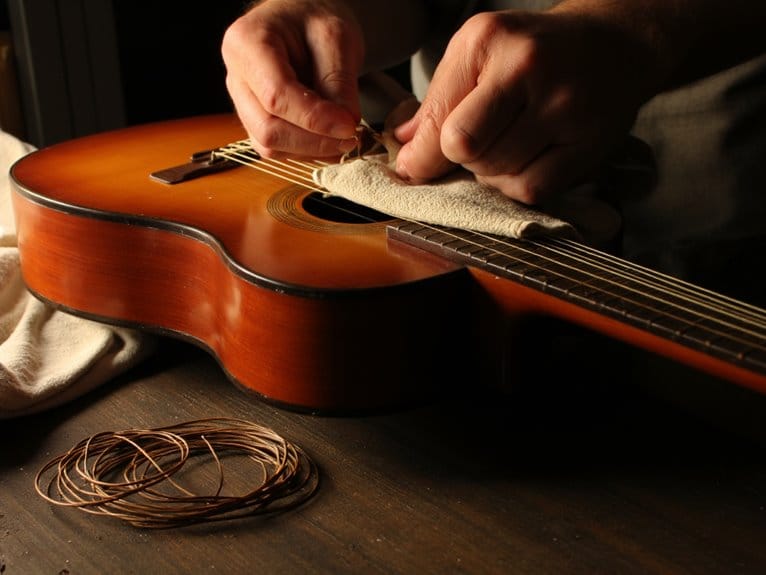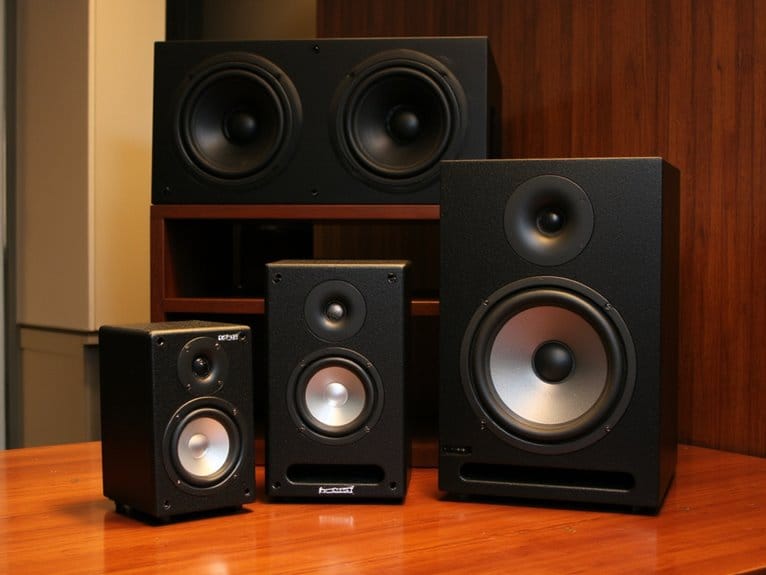Cymbal Stands and Hardware That Lasts
You’ll want heavy-duty cymbal stands with double-braced legs and 22mm steel tubing, since lightweight models buckle under aggressive playing while premium construction handles decades of touring abuse. I’ve seen too many hardware failures during performances, but stands like the DW 9700 and Pearl BC-930 feature reinforced joints, quality wing nuts, and corrosion-resistant materials that prevent embarrassing collapses. Proper maintenance and component selection determine whether your investment survives countless gigs ahead.
We are supported by our audience. When you purchase through links on our site, we may earn an affiliate commission, at no extra cost for you. Learn more.
Notable Insights
- Heavy-duty double-braced stands with 22mm tubing and reinforced joints provide superior stability for aggressive playing and professional touring.
- Premium steel construction with thick-walled tubing resists bending and buckling better than lightweight alternatives during intense performances.
- Regular maintenance including lubrication, felt replacement, and hardware inspection significantly extends cymbal stand lifespan and prevents failures.
- Quality protective components like brass sleeves, rubber feet, and proper felts prevent metal damage and maintain secure cymbal positioning.
- Professional models like DW 9700, Pearl BC-930, and Tama Roadpro HC83BW offer proven durability through countless gigs.
Heavy-Duty Vs Lightweight Stand Construction
Two fundamental approaches define cymbal stand construction, and I’ve found that understanding the difference between heavy-duty and lightweight designs can save you from countless frustrations during performances.
Heavy duty advantages become apparent when you’re dealing with larger cymbals or aggressive playing styles, as double-braced legs and 22mm diameter tubing provide the stability that prevents embarrassing mid-song collapses.
Lightweight drawbacks surface quickly under stress, where single-braced legs and simpler tilt locks can’t handle the demands of intense drumming sessions. Weighted bases ranging from 4.5 to 10 pounds are essential for preventing wobbling during aggressive performances.
While lightweight stands excel in portability for frequent gigging, I’ve learned that their weight savings often come at the expense of reliability when you need it most. Just as drummers must consider their playing style when selecting equipment, heavy hitters require more robust hardware construction to withstand their aggressive performance demands. Professional drummers consistently choose durable brands like DW, Tama, and Pearl because these manufacturers deliver long-lasting gear that withstands the rigors of regular performance. Proper tuning precision requires stable hardware that won’t shift during extended playing sessions, making quality stands essential for maintaining consistent sound quality. The choice of cymbal stand affects the configuration of the drum kit and can enhance solos and overall sound.
Materials and Build Quality for Maximum Durability
When you’re investing in cymbal stands that’ll withstand years of aggressive playing and constant transport, premium steel construction becomes your best friend, offering unmatched strength and resistance to bending that cheaper materials simply can’t match.
I’ve seen too many lightweight stands buckle under the weight of heavy rides or crash under enthusiastic playing, which is why double-braced tripod legs aren’t just a luxury feature—they’re essential for maintaining stability when you’re really laying into your cymbals.
You’ll find that this robust foundation, combined with thick-walled steel tubing and reinforced joint connections, creates a platform that won’t wobble, slip, or collapse when you need reliability most. The inclusion of rubber feet not only protects your cymbals from damage but also provides superior grip across different floor surfaces, preventing unwanted sliding during intense performances. Quality hardware mirrors the same construction principles found in bronze alloy cymbals, where superior materials and craftsmanship directly translate to enhanced durability and performance reliability. While budget-conscious drummers often gravitate toward lighter options for their affordable price, investing in heavy-duty construction pays dividends in long-term reliability and performance consistency.
Professional drummers understand that memory locks are crucial for maintaining consistent setup positioning, eliminating the frustration of readjusting hardware between songs or sets.
Premium Steel Construction Benefits
While I’ve tested dozens of cymbal stands over the years, I can tell you that premium steel construction represents the single most essential factor separating professional-grade hardware from budget alternatives that’ll leave you frustrated during critical performances.
The premium construction advantages become immediately apparent when you’re dealing with heavy rides or aggressive playing styles, as thicker gauge steel resists bending and maintains structural integrity through countless setups.
Quality protective coatings prevent rust while precision-machined components guarantee your adjustments stay locked during intense sessions. Similar to how bronze construction provides warmth and richness that professionals prefer in their cymbals, premium steel delivers the reliability and tonal support your hardware demands.
Sure, you’ll pay more upfront, but the long term cost effectiveness becomes undeniable when these stands outlast three budget replacements, maintaining smooth operation and reliable cymbal positioning year after year.
Just as drummers invest in dual-ply construction for their snare heads to achieve superior durability and controlled sound, the same principle applies to cymbal hardware where reinforced materials deliver the reliability professionals demand.
Double-Braced Tripod Stability
Since I’ve had countless cymbal stands collapse during crucial moments over two decades of testing, I can assure you that double-braced tripod construction isn’t just marketing hype—it’s the difference between reliable performance and embarrassing hardware failures.
The tripod advantages become immediately obvious when you’re hammering away at crash cymbals during intense passages, as that additional bracing reinforces each leg while distributing weight evenly across the base.
When conducting stability comparisons between single and double-braced models, the parallel bar bracing consistently outperforms lighter alternatives by preventing wobbling and reducing tipping risks. Just as build quality affects the durability and longevity of musical instruments, the same principle applies to cymbal hardware where superior materials and construction methods determine long-term reliability.
Those rubber anti-skid feet work in tandem with the reinforced tripod configuration, creating what I consider the gold standard for cymbal hardware that won’t let you down mid-performance. Professional drum modules with velocity-sensitive pads require equally dependable hardware to maintain consistent triggering accuracy throughout demanding performances.
Just as professional drummers invest in quality mounting hardware to prevent microphone positioning failures during critical recording sessions, the same principle applies to cymbal stands where reliable hardware is essential for maintaining setup integrity throughout demanding performances.
Stand Types and Design Features That Enhance Longevity
Although I’ve tested dozens of cymbal stands over the years, I’ve learned that the type of stand you choose fundamentally determines how long your hardware will survive the rigors of regular playing. Heavy-duty stands with thicker steel tubing consistently outlast lightweight models, while double-braced legs provide essential stability that prevents wobbling and joint stress during aggressive performances.
| Stand Type | Durability Rating | Best For |
|---|---|---|
| Heavy-duty Double-braced | Excellent | Touring/Heavy Play |
| Convertible Boom/Straight | Very Good | Versatile Setups |
| Lightweight Straight | Good | Practice/Light Use |
The adjustability benefits of quality locking mechanisms can’t be overstated—memory locks and secure wing nuts reduce mechanical strain from repeated setup cycles, while vinyl tubing and cymbal felts minimize metal-on-metal contact that accelerates wear on vital mounting points. Just as musicians benefit from noise reduction gear to protect their hearing during loud performances, investing in quality hardware components protects your equipment investment over time. Similar to how microphones need proper positioning 2-6 inches from the sound source, cymbal stands require precise placement and stable mounting to prevent movement during play and ensure optimal performance longevity. Just like bronze alloy cymbals offer superior sound complexity compared to brass alternatives, premium stand materials and construction methods enhance both performance reliability and equipment lifespan.
Critical Hardware Components That Impact Lifespan
Beyond choosing the right stand design, the individual components that make up your cymbal hardware determine whether you’ll be replacing parts every few months or enjoying years of reliable performance.
High-grade steel wing nuts and tilter mechanisms resist stripping under frequent adjustments, while brass or nylon sleeves prevent metal-on-metal contact that causes keyholing in your cymbals.
I’ve learned that cymbal protection starts with quality felts and washers, which reduce friction and maintain proper alignment during play.
When considering hardware upgrades, focus on double-action locking arms with larger surface areas that minimize slippage, and invest in reinforced welds at critical joints.
Regular replacement of worn sleeves and protective components prevents costly cymbal damage down the road.
Top-Rated Durable Cymbal Stand Models
The marketplace offers several standout cymbal stands that’ve earned their reputations through years of professional use, and I’ve found that certain models consistently deliver the durability and performance that serious drummers demand.
The DW 9700 Boom Cymbal Stand tops my list for touring reliability, supporting heavy cymbal weight while providing adjustable height beyond 50 inches.
Pearl’s BC-930 excels with its Unilock tilting system and exceptional stability for stationary setups, though it’s admittedly hefty.
Tama’s Roadpro HC83BW offers excellent value, balancing portability with sturdy construction that handles substantial cymbal weight effectively.
Each features double-braced legs and robust locking mechanisms that’ve withstood countless gigs, making them worthwhile investments for serious players.
On a final note
You’ll find that investing in quality cymbal stands isn’t just about protecting your cymbals—it’s about protecting your investment in your entire kit. Whether you’re choosing heavy-duty construction for touring or lightweight options for practice, remember that proper maintenance extends any stand’s lifespan considerably. Don’t overlook those critical hardware components like wing nuts and tilters, because they’re often what fails first when you need reliability most.






